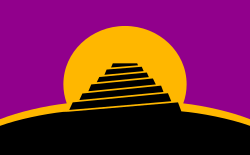Portal:Constructed languages
Introduction

A constructed language (shortened to conlang) is a language whose phonology, grammar, orthography, and vocabulary, instead of having developed naturally, are consciously devised for some purpose, which may include being devised for a work of fiction. A constructed language may also be referred to as an artificial, planned or invented language, or (in some cases) a fictional language. Planned languages (or engineered languages/engelangs) are languages that have been purposefully designed; they are the result of deliberate, controlling intervention and are thus of a form of language planning.
There are many possible reasons to create a constructed language, such as to ease human communication (see international auxiliary language and code); to give fiction or an associated constructed setting an added layer of realism; for experimentation in the fields of linguistics, cognitive science, and machine learning; for artistic creation; for fantasy role-playing games; and for language games. Some people may also make constructed languages as a hobby, or in connection to worldbuilding.
The expression planned language is sometimes used to indicate international auxiliary languages and other languages designed for actual use in human communication. Some prefer it to the adjective artificial, as this term may be perceived as pejorative. Outside Esperanto culture, the term language planning means the prescriptions given to a natural language to standardize it; in this regard, even a "natural language" may be artificial in some respects, meaning some of its words have been crafted by conscious decision. Prescriptive grammars, which date to ancient times for classical languages such as Latin and Sanskrit, are rule-based codifications of natural languages, such codifications being a middle ground between naïve natural selection and development of language and its explicit construction. The term glossopoeia is also used to mean language construction, particularly construction of artistic languages.
Conlang speakers are rare. For example, the Hungarian census of 2011 found 8,397 speakers of Esperanto, and the census of 2001 found 10 of Romanid, two each of Interlingua and Ido and one each of Idiom Neutral and Mundolinco. The Russian census of 2010 found that in Russia there were about 992 speakers of Esperanto (the 120th most common) and nine of the Esperantido Ido. (Full article...)
Selected language

Sindarin is a fictional language devised by J. R. R. Tolkien for use in his fantasy stories set in Arda, primarily in Middle-earth. Sindarin is one of the many languages spoken by the immortal Elves, called the Eledhrim [ɛˈlɛðrim] or Edhellim [ɛˈðɛllim] in Sindarin. The word Sindarin is itself a Quenya form. The only known Sindarin word for this language is Eglathrin, a word probably only used in the First Age (see Eglath).
Called in English "Grey-elvish" or "Grey-elven", it was the language of the Sindarin Elves of Beleriand. These were Elves of the Third Clan who remained behind in Beleriand after the Great Journey. Their language became estranged from that of their kin who sailed over sea. Sindarin derives from an earlier language called Common Telerin, which evolved from Common Eldarin, the tongue of the Eldar before their divisions, e.g., those Elves who decided to follow the Vala Oromë and undertook the Great March to Valinor. Even before that the Eldar Elves spoke the original speech of all Elves, or Primitive Quendian.
In the Third Age (the setting of The Lord of the Rings), Sindarin was the language most commonly spoken by most Elves in the Western part of Middle-earth. Sindarin is the language usually referred to as the elf-tongue or elven-tongue in The Lord of the Rings. When the Quenya-speaking Noldor returned to Middle-earth, they adopted the Sindarin language. Quenya and Sindarin were related, with many cognate words but differing greatly in grammar and structure. Sindarin is said to be more changeful than Quenya, and there were during the First Age a number of regional dialects. Find out more...
Did you know...
...that Volapük, a constructed language which once attracted thousands, now has, at most, 30 speakers?
...that Volapük nevertheless has its own Wikipedia, the Vükiped?
...that during the mid 19th century The Church of Jesus Christ of Latter-day Saints briefly advocated the use by its members of the Deseret alphabet in place of the Latin one?
Current events
(none)
Corresponding categories
Projects

|
You are invited to participate in WikiProject Constructed languages, a WikiProject dedicated to developing and improving articles about constructed languages. |
Things you can do
-
Join: Constructed Languages WikiProject & add {{Wikipedia:WikiProject Constructed languages/Userbox}}
Follow: Recent changes in related articles
Tag: {{WP conlangs}}, {{Constructed languages}}, and {{Infobox language}} (see WP:CL Templates)
Evaluate: Everything in Category:Unassessed constructed language articles
Report: Edit wars and deletions
Expand: everything in category:Constructed language stubs
Requests:
-
Abakwi, Ancient Language, Arovën, Baza, Bluddian, Dremlang, Eaiea, Eloi, Ekspreso, Esperando, Fasile, Glide, Herman Miller, Language Creation Society, Latejami, Mezhdunarodny Nauchny Yazyk, Mirad, Modern Indo-European, Mondlango, Musbrek, Noxilo, Or'zet, Romanica (rd), Romanova (rd), Signuno, Sperethiel, Szkev, Tceqli/Ceqli, Thosk, Tokcir, Troscann, Unas, UNI, Universalspråket, Vorlin.
Web resources

Some Internet resources relating to constructed languages, by Richard Kennaway
UniLang.org
Conlang wiki
Articles
Wikipedia in constructed languages
Associated Wikimedia
The following Wikimedia Foundation sister projects provide more on this subject:
-
Commons
Free media repository -
Wikibooks
Free textbooks and manuals -
Wikidata
Free knowledge base -
Wikinews
Free-content news -
Wikiquote
Collection of quotations -
Wikisource
Free-content library -
Wikiversity
Free learning tools -
Wiktionary
Dictionary and thesaurus














